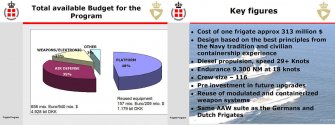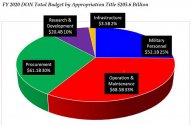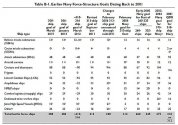I think you are seriously understimating how fast AI advances and that it is actually accelerating now (and even more in the future). There have already been talks about how AI is now learning to dogfight in the air.
There also reports on how the PLA is planning (already in R&D, unknown how much they advanced) to use AI to help a commander on making tactical decisions.
AI is advancing so fast that we might actually see 6th gen systems coming out sooner than we thought they would.
For now all these are in heavy R&D with a lot of progress happening. The XLUUV is a good example on what the US Navy is planning to do. Ofc manned submarines will be more capable than AI-enabled drone subs in the near-to-medium future. But I fully expect that in max 12 (10?, <10?) years AI subs will be able to hunt enemy submarines
Anyways this is a bunch of theorycrafting. My point was that underwater drones shouldn't be underestimated. We are now moving from platform vs platform warfare to a system of systems warfare.
Quite to the contrary. It is you who underestimates the challenges that any intelligent system will and must encounter in its evolutionary path.
Evolution occurs under evolutionary pressure not as spontaneous generation of traits. For any system to evolve it needs to contest evolutionary space against a rival, often a predator. This is straight from mathematics. Evolution is like flow. If it is unrestricted (no pressure) it goes everywhere and the fluid disperses. If it is restricted (pressure) it begins to form a coherent fast-moving stream.
It doesn't matter how well AI does during simulated dogfights because AI simulated dogfights since the advent of PC gaming
Development of AI is just evolution of basic behavioral traits which are abstracted into the digital environment and it is governed by the same mathematics. It's just that the people who write about AI for the general public are not the same people who develop or study AI and/or evolution. Quite to the contrary they are among the dumbest individuals who are drawn to the subject because they believe that using buzzwords will make them seem smarter. This is why we persist with "AI" even though it's not a real thing at all. Machine intelligence is preferred term in the field and even then it's only because these machines do not meet the fundamental criterion for life - self-reproduction. Any machine that can reproduce is alive and is no longer a machine in the traditional sense.
Anyway, returning to the problem at hand...
This is why I mentioned the isolation of underwater drones. An isolated system can be deceived more easily because the total information and adaptive potential is limited. Things will go differently with surface drones because they will have the access to the same pools of information and adaptive potential as crewed ships. Not only that the combination of human and machine intelligence will be by default superior in the next several decades - again, for mathematical reasons.
Imagine the information problem as a kinetic problem. Your underwater drone's AI is a company commander. The obstacle or problem is the enemy defensive position in the town you are meant to capture. You can't because the enemy has matched you strength. If you are an underwater drone you're on your own, and that is true for all foreseeable future because of information flow in water. If you are a surface drone you can relay the problem to the higher echelon and the additional intelligence will work like an artillery strike or a couple of jets doing a bombing run. They will clear the path for you if you are stuck. The underwater drone is on its very small own.
XLUUVs are meant to replace expensive nuclear submarines in menial tasks: underwater mining, basic surveillance, decoys, tasking enemy ASW forces with unindentified presence. In strike capability they will have to know a specific target with pre-programmed libraries of acoustic signatures which makes them into a cruise missile more than a "unmanned ship". They will also be susceptible to enemy deception.
They will not replace submarines because they can't - in physical terms, as in physics limits what they can do.
All other drones that can be linked together - that's another story. You should never compare UAVs and USuVs to UUVs because an unmanned surface ship, unmanned aerial vehicle and an unmanned orbiter have more in common in how they operate and what they are capable of than an unmanned underwater system.
In simplest terms - there's a reason why in the ocean depths you can still find fish from the Dewonian and why no significantly intelligent organism emerged in the marine ecosystem and why the best is most likely the octopus which can't form societies because it's stuck in an evolutionary dead end.
There's also a reason why the most sophisticated marine ecosystems are more fragile than terrestrial ecosystems.
Once you put all that into the form of numbers the answers are clear and "artificial intelligence" is just a special case of the general problem. The military planners know that if they're smart to listen to people smarter than them, and if they don't then the simulations written by those smarter people provide them with results that they can't ignore. Mathematics is incapable of lies.
Anyway - my point is that the XLUUVs and their equivalents in other countries are misunderstood because ignorant people in the media are throwing them into the same bag as unmanned ships or aircraft to sell their content. Large underwater drones are useful tools for augmenting of submarine operations and a replacement for some of them. But here again the impressions on what submarines do in actual life is governed by the ignorance of general public. People read Clancy's Hunt and think they are as good as a submariner.
Also as far I know currently the largest number of XLUUVs programmed for the 30-year period by any organization is 40 systems. That's from the Hudson Institute's white paper that accompanied the 30-year-plan and is treated as an unofficial alternative like a minority report.

The number of SSNs is greater by 50% than the number of XLUUVs and there's a reason for it that I just explained in the broadest strokes possible. This table has 99 MUSVs but the plan also postulates 80 DDCs which is a large corvette capable of cooperating with the drones. You could in theory replace some of those corvettes with drones and you can plan for 200 or 300 surface drones and have plenty of alternatives on how you use them as a platform. There's a limited use for underwater drones that are not directly physically linked to a submarine and any drone that is linked to a submarine has to take up valuable space.
Also here's another table detailing how Hudson imagined task force composition including undersea operations. They postulate a "wolf pack" approach for submarines:

Two "wolfpacks", each consisting of seven submarines and seventeen XLUUVs. This should give you an impression of what the actual role of an XLUUV might be in such formation.
Deepest apologies for the overlong and somewhat confusing explanation. Semi-professionally this is very close to my field. This is also why I'm watching the China vs America contest. I do it for different reasons than most people here and it's reflected in the content my posts.







![Figure A2-1 [640px].jpg Figure A2-1 [640px].jpg](https://www.sinodefenceforum.com/data/attachments/67/67125-b168a715912172e48002c20f3607e8fd.jpg)

